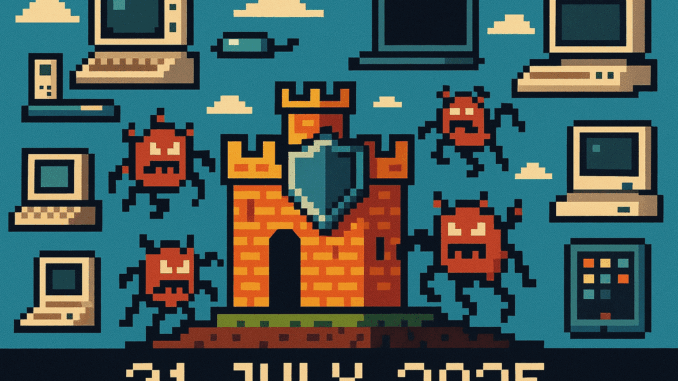
There’s a certain tension when your login screen flickers, isn’t there? Tech Brief 21 July 2025 explores the digital world’s latest twists, from headline-grabbing cyberattacks to the ethical tangles of artificial intelligence and the colourful evolution of laptops. Missed yesterday’s Tech Brief? Catch up here before diving in.
NCSC Attributes Authentic Antics Malware to Fancy Bear
For anyone who’s ever worried about their online accounts, Britain’s National Cyber Security Centre (NCSC) just made it clear that vigilance is still vital. The NCSC has formally attributed a series of sophisticated malware attacks to Russia’s Fancy Bear group, identifying the malware as Authentic Antics. This campaign targeted authentication protocols across UK infrastructure, and arrived just as new government sanctions were announced against Moscow. Manuals from the late 80s warned us not to use “password” as our password; advice that, astonishingly, still holds up in 2025. Today’s attacks are slicker, but the core lesson remains: secure your endpoints, monitor for anomalies, and never underestimate adversaries’ persistence. The NCSC’s public attribution signals a shift toward transparency in cyber defence, and for anyone responsible for a network, it’s a call to double-check the basics.
DWP Faces Scrutiny Over AI Systems for Benefit Claimants
Why does algorithmic transparency matter? Amnesty International and Big Brother Watch have accused the Department for Work and Pensions (DWP) of quietly testing AI systems that treat benefit claimants as “automatically suspicious,” without enough public oversight. The DWP’s reluctance to reveal details about these deployments has sparked debate about privacy and accountability. Over the decades, government tech projects have often sparked debate about surveillance and citizen rights, from early database rollouts to today’s machine learning models. This latest dispute highlights the need for clear ethical frameworks when deploying AI in public services. As technology evolves, so do the risks of unintended bias and lack of recourse for affected individuals. For anyone who’s ever worried about a faceless algorithm making decisions, this story is a reminder to demand transparency and fairness at every stage.
Charities Struggle to Find the Skills to Adopt AI
UK charities are facing a real challenge adopting artificial intelligence, not because they lack ambition, but because of a widening digital skills gap. Many smaller organisations want to use AI for community-focused work, but find themselves short on expertise and resources. This situation brings to mind the resourcefulness seen with the rise of home computers when limited budgets led to creative solutions, and local clubs filled knowledge gaps. Today, the stakes are higher and the technology more complex, but the same spirit of innovation persists. Industry observers suggest that without targeted support, grassroots innovation could stall. For anyone interested in supporting community tech, now is the time to share skills and experience. Imagine if today’s AI models could be powered by the combined energy of every ZX Spectrum in Britain; we’d still need a few million more, but the collaborative spirit would be the same.
Netflix Uses Generative AI in Sci-Fi Series El Eternauta
Netflix has introduced generative AI to its new sci-fi series El Eternauta, marking the company’s first use of artificial intelligence for creative production. The move is billed as a way to enhance quality, not just cut costs, yet it has drawn criticism from copyright advocates and fans of traditional effects. Since the days of VHS and practical model-making, each leap in technology has prompted debate about authenticity and artistic control. For viewers, this development raises questions about the future of storytelling and the value of human creativity. The industry’s response will shape how AI is integrated into entertainment, and whether audiences embrace or resist the change. For anyone who’s ever marvelled at a hand-built model spaceship, the conversation around AI in media is a chance to ask what we want from our stories.
From the Wayback Machine
On This Day: 1999 – Apple Launches the iBook G3
On 21 July 1999, Steve Jobs unveiled the Apple iBook G3 at Macworld in New York. The iBook G3 featured a 300 MHz PowerPC processor, a 12.1-inch display, and the first mainstream use of integrated Wi-Fi, branded as AirPort. Its colourful “clamshell” design, available in Tangerine and Blueberry, broke away from the grey monotony of business laptops. It’s easy to credit Steve Jobs, but let’s not forget Jonathan Ive and the team of engineers who made the iBook’s bold design possible. The iBook’s built-in Wi-Fi wasn’t just a technical leap; it meant students could finally write essays in the garden, not just at the kitchen table. With the introduction of the iBook G3, laptop design shifted toward style and wireless connectivity, influencing both Apple and the wider industry for years to come.
What This Means
Tech Brief 21 July 2025 shows how digital challenges are rooted in decades of technical and cultural evolution. From cyberattacks to creative AI, the need for transparency, skills, and thoughtful design is as urgent as ever. Let’s keep the conversation open and share what we’re learning.
Stay curious, keep tinkering, and always look for the story behind the silicon. What’s your most memorable tech surprise? Share your story and let’s keep curiosity alive.
Missed yesterday’s Tech Brief? Catch up here.

Leave a Reply